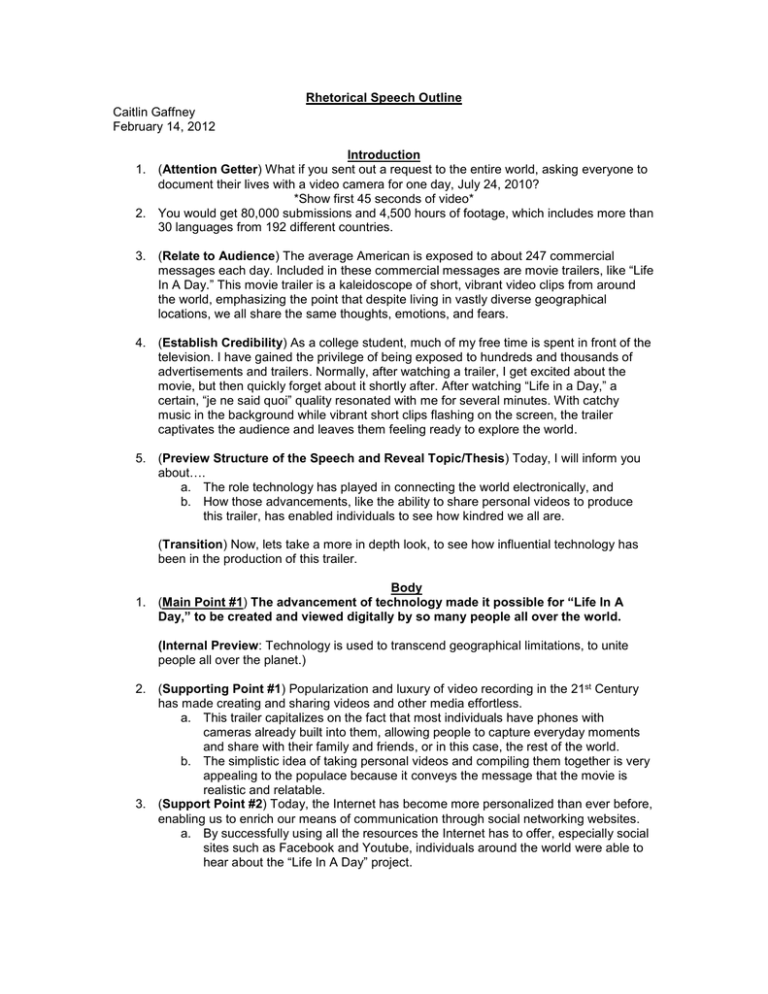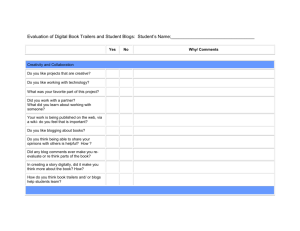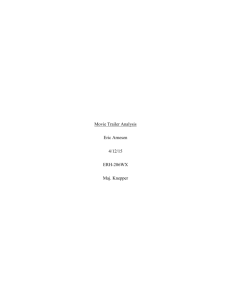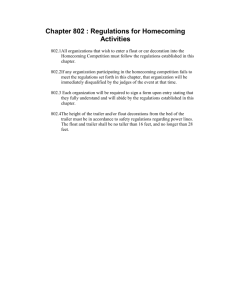final outline for rhetorical analysis speech
advertisement

Rhetorical Speech Outline Caitlin Gaffney February 14, 2012 Introduction 1. (Attention Getter) What if you sent out a request to the entire world, asking everyone to document their lives with a video camera for one day, July 24, 2010? *Show first 45 seconds of video* 2. You would get 80,000 submissions and 4,500 hours of footage, which includes more than 30 languages from 192 different countries. 3. (Relate to Audience) The average American is exposed to about 247 commercial messages each day. Included in these commercial messages are movie trailers, like “Life In A Day.” This movie trailer is a kaleidoscope of short, vibrant video clips from around the world, emphasizing the point that despite living in vastly diverse geographical locations, we all share the same thoughts, emotions, and fears. 4. (Establish Credibility) As a college student, much of my free time is spent in front of the television. I have gained the privilege of being exposed to hundreds and thousands of advertisements and trailers. Normally, after watching a trailer, I get excited about the movie, but then quickly forget about it shortly after. After watching “Life in a Day,” a certain, “je ne said quoi” quality resonated with me for several minutes. With catchy music in the background while vibrant short clips flashing on the screen, the trailer captivates the audience and leaves them feeling ready to explore the world. 5. (Preview Structure of the Speech and Reveal Topic/Thesis) Today, I will inform you about…. a. The role technology has played in connecting the world electronically, and b. How those advancements, like the ability to share personal videos to produce this trailer, has enabled individuals to see how kindred we all are. (Transition) Now, lets take a more in depth look, to see how influential technology has been in the production of this trailer. Body 1. (Main Point #1) The advancement of technology made it possible for “Life In A Day,” to be created and viewed digitally by so many people all over the world. (Internal Preview: Technology is used to transcend geographical limitations, to unite people all over the planet.) 2. (Supporting Point #1) Popularization and luxury of video recording in the 21st Century has made creating and sharing videos and other media effortless. a. This trailer capitalizes on the fact that most individuals have phones with cameras already built into them, allowing people to capture everyday moments and share with their family and friends, or in this case, the rest of the world. b. The simplistic idea of taking personal videos and compiling them together is very appealing to the populace because it conveys the message that the movie is realistic and relatable. 3. (Support Point #2) Today, the Internet has become more personalized than ever before, enabling us to enrich our means of communication through social networking websites. a. By successfully using all the resources the Internet has to offer, especially social sites such as Facebook and Youtube, individuals around the world were able to hear about the “Life In A Day” project. (Transition: With the capability of technology in hand, (literally!) we are now able to see exactly how alike human beings across the globe are.) *Show from 45-1:45* 1. (Main Point #2) While the trailer for “Life In A Day” allows cultures to see the distinctiveness of each culture, it more importantly permits everyone to see how similar we are. Internal Preview: Despite being spread out across millions of miles of land and water, people are exceptionally more akin than imagined. 2. (Supporting Point #1) Everyone in the world fundamentally matures through the same developmental processes. a. From a biological standpoint, we all learn to crawl, walk, stand, and run. We all breathe, digest food, and have blood pumping through our veins. 3. (Supporting Point #2) In addition to developing similarly, individuals are creatures of habit, and therefore have relatable habits that can be seen cross-culturally a. From a social/ cultural standpoint, people essentially engage in the same habits. While each culture has their own variation of the custom or belief, fundamentally, they are all the same. i. For example, individuals all wear clothing, express love through marriage, eat various types of food, learn the customs and ways of our culture, love sporting events, and enjoy/take part in musical festivals. b. The essential core of our existence is our ability to adapt and learn from others in our own culture, as well as others in diverse cultures. 4. (Supporting Point #3) Furthermore, individuals around the globe experience and feel the same emotions. a. Everyone feels scared, loved, happiness, anger, worried, and hopeful, excited, sad, and unsure, at some point in their lives. b. Emotions are a universal language, without the use of dialogue. i. 6 Universal Emotions (how we are able to know what they feel by their facial expression) 1. Happiness; Sadness; Surprise; Fear; Disgust; Anger (Internal Summary: Individuals around the world are biologically and culturally more alike, than we are different.) (Transition: Now we are able to understand how similar human begins are around the world, due to the recent technological advances.) Conclusion 1. (Summarize main ideas and re-emphasize thesis) With the improvement of technology, we are able to view movie trailers, like “Life In A Day,” from the palm of our hands. The ease and accessibility of the Internet allows us to acquire more knowledge faster and with considerably less effort than before. We are able to learn more about our own culture, as well as exploring other cultures that make up the rest of the world. After gaining knowledge about other cultures, we are able to see how similar we are, despite the physical, cultural, and geographical differences. By allowing the audience to be full mesmerized and enthralled in the trailer, it becomes a useful tool in educating people about cultural differences and similarities in an engaging and fun way. “Life In A Day,” is a way to “bring to people together” to show them what really matters in life. This trailer emphasizes how much life has to offer, all we have to do is go out and experience it. 2. (Memorable Closing Statement) Think of the world as one pig puzzle. Each country and culture is a small piece of the bigger picture. Every culture is distinguishable, just like each puzzle piece is different from the others. By just looking at a pile of puzzle pieces, it is hard to see how we all fit together. However, despite external differences, each piece is able to come together to make a beautiful bigger picture: image of a world full of life. References "How Many Ads Are We Exposed to Daily??" Free By 50. Free By 50, 21 June 2011. Web. 14 Feb. 2012. <http://www.freeby50.com/2011/06/how-many-ads-are-weexposed-to-daily.html>. Hung, Daniel D., and Heji Kim. "Six Universal Expressions." Department of Neurobiology and Behavior - Cornell University. 20 Apr. 1996. Web. 14 Feb. 2012. <http://www.nbb.cornell.edu/neurobio/land/oldstudentprojects/cs49095to96/hjkim/emotions.html>. Life in a Day Trailer. Prod. Ridley Scott. Dir. Kevin Macdonald. YouTube - Broadcast Yourself. National Geographic, 21 Apr. 2011. Web. 14 Feb. 2012. <http://www.youtube.com/watch?v=bT_UmBHMYzg>. "Oceans of the World - 5 Oceans, World Oceans - Worldatlas.com." World Atlas including Geography Facts, Maps, Flags - Worldatlas.com. World Atlas. Web. 14 Feb. 2012. <http://www.worldatlas.com/aatlas/infopage/oceans.htm>. Pingdom. "Internet 2010 in Numbers | Royal Pingdom." Pingdom Web Site Monitoring Blog - Everything about Uptime, Downtime, Servers, Internet and Technology. Pingdom, 12 Jan. 2011. Web. 14 Feb. 2012. <http://royal.pingdom.com/2011/01/12/internet-2010-in-numbers/>. "World Internet Usage Statistics News and World PopulationStats." Internet World Stats - Usage and Population Statistics. Internet World Stats, 8 Feb. 2012. Web. 14 Feb. 2012. <http://www.internetworldstats.com/stats.htm>.






